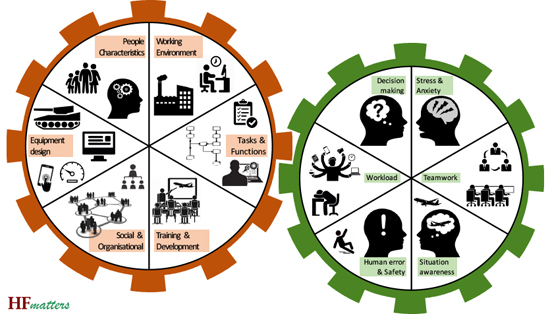|
Human Factors as a scientific discipline is concerned with applying specialised information and data about human characteristics, capabilities and limitations to the design of the tools, equipment and systems that humans use, the tasks and jobs that they perform, and the environments in which they work. Human Factors matters because it helps to ensure that all of these things function as efficiently, effectively, safely and comfortably, as possible.
Human Factors is important to virtually every human artefact, from simple everyday consumer gadgets and products to complex equipment and machinery, to advanced technological systems operated by specially trained users. But where Human Factors matters most is in the design of complex, often safety critical, systems such as aircraft cockpits/flightdecks, air traffic control centres, control rooms for utility industries, transport and healthcare systems, and of course military command & control centres and related operations rooms. These systems are often highly computerised with varying degrees of automation. If Human Factors is not properly considered there is the risk of not only poor system effectiveness, but accidents with serious and possibly catastrophic consequences. In the design of complex 'human-machine systems', Human Factors is not just desirable, but essential.
Given the inherent, multi-disciplinary nature of Human Factors, it covers a wide range of human-related subjects. As illustrated in the figure below (left cogwheel), there are six main technical areas: People characteristics (i.e. their physical, perceptual and psychological capabilities and limitations); Equipment design; Working environment (including health & safety); Training and Development; Tasks & Functions (i.e. work activities that people perform including the interaction with automation); and Social & Organisational (including culture, change management and transition).
|
|
Whatever the types of work undertaken in whichever working environment, human performance is characterised and influenced by a number of different psychological factors. As also illustrated in the above figure (right cogwheel), there are six main factors: Decision making (including judgement, cognitive biases and intuition); Stress and Anxiety; Workload (low as well as high), Teamwork (including communication, coordination and leadership); Human error and Safety; and Situation awareness.
(NB. The HFmatters 'cogwheels' figure is a variation of the EUROCONTROL Human Factors Gearbox, which distinguished six System level factors interacting with six Human Performance level factors. However, these two sets of factors are not fixed, and the multivarious aspects of Human Factors can be categorised and emphasised in different ways; hence, the above cogwheels. Interestingly, the Gearbox itself was based on the earlier Human Factors 'Pie', developed as part of the EUROCONTROL Human Factors Case methodology.)
|


